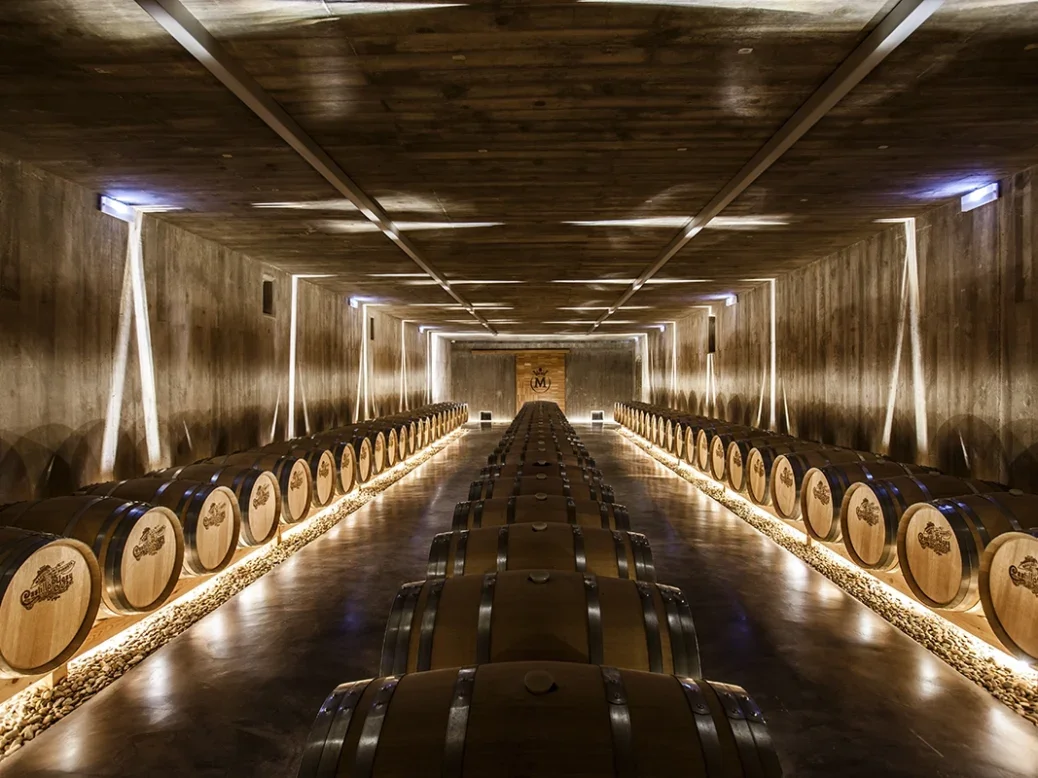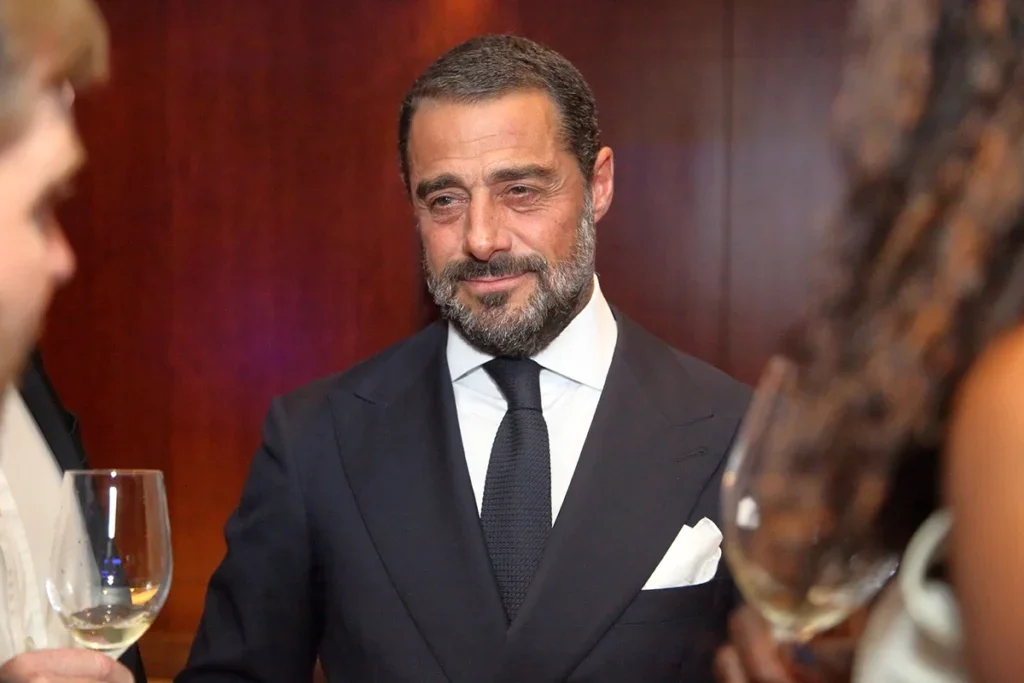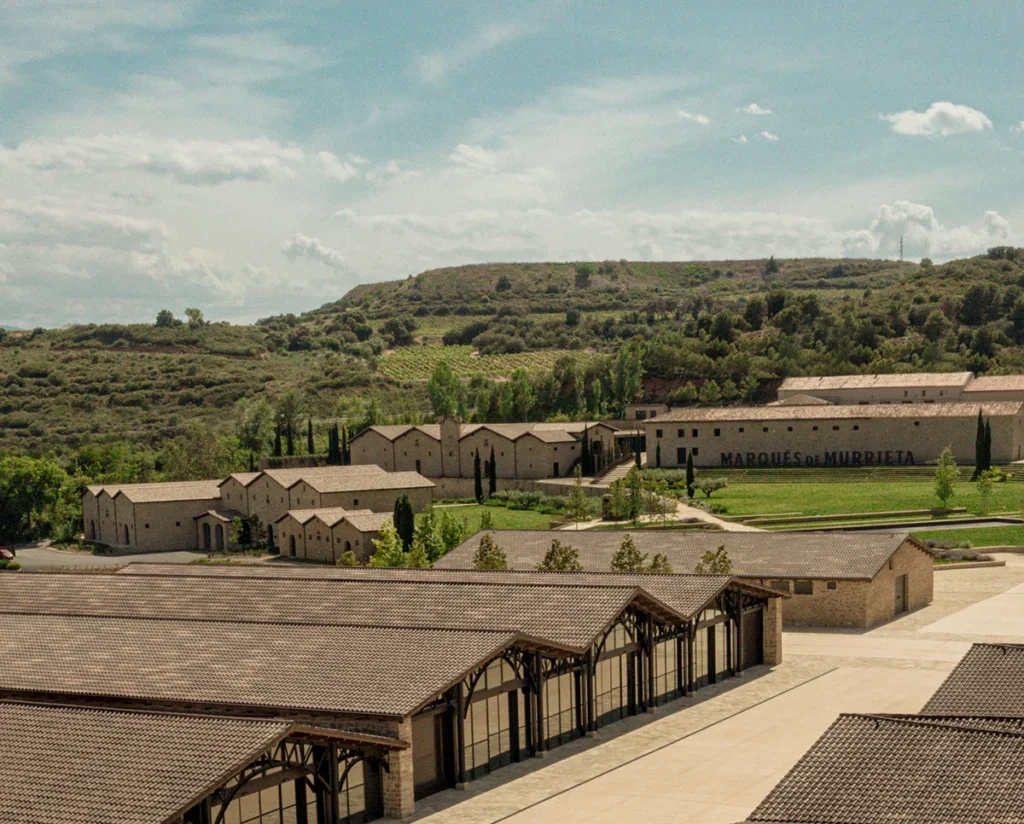
There has been a subtle but significant shift in the winemaking approach at the venerable Rioja estate, Marqués de Murrieta, but the underlying quality remains, says Simon Field MW after a fascinating tasting featuring wines both young and old.
As symbolism goes, one cannot do much better than the 34th floor of The Shard, London’s (and the UK’s) tallest building—beneath us, the bright lights of the big city, and around us, the trappings of 170 years of vinous excellence. Add to this the fact that we are in the Shangri-La hotel, and the symbolism starts to dance playfully around the ancient bottles of Rioja… An earthly paradise to look up to, albeit through autumnal, Dickensian smog rather than Tibetan mist. Either way, a definitive statement is being made. The 70 guests are impressed.
Presiding imperiously is the charismatic Vicente Dalmau Cebrián-Sagarriga, Count of Creixell, the man with the largest business card I have ever seen. Read into that what you will. Vicente inherited the familial property suddenly in 1996 on the early death of his father, also Vicente, who had purchased the winery in 1983. Before that, it had been in the hands of the heirs of Luciano Murrieta, the original marquis, who had founded it in 1852 with an aspiration to import savoir faire from Bordeaux and then to export fine wines from Rioja, itself unusual at the time. A huge influence, therefore, with Rioja itself benefiting ever since from his technical and commercial acumen. The Creixell dynasty, for its part, is Galician and can trace ownership of its Rías Baixas property, Pazo Barrantes, to the 16th century. Vicente now presides over both, aided by his sister Cristina and, since 2000, by the highly valued winemaker Maria Vargas.
Vicente is dapper, with a confident Castilian swagger and a healthy self-belief. Titian’s Holy Roman Emperor—minus, on this occasion, the horse. He speaks of “revolution in Rioja” and a seminal year for Marqués de Murrieta; of the personal cathartic project that is Dalmau; and of the “demise” of Garnacha—grandiose statements all, and all needing a degree of unpicking.

The seminal year in question is 2018, the vintage of the latest release of the Murrieta Reserva. The significance can be found in the fact that it was the start of the complete renovation of the winery—now 270,000 sq ft (25,000 sq m) of splendor, oak, and steel winking at each other behind the thick stone of the Castillo de Ygay—and in a concomitant paradigm shift in winemaking, which centers on a modification (and generally reduction) in the oak aging, most especially in Dalmau and in the white, Capellanía. The changes are subtle yet significant: Long gone are the days when the top wines were aged for ten years in American oak; purity and structural definition are now key. The mood music is respectful of tradition, and adagio of temperament, since the wines are released at different times. There is, nonetheless, a nostalgic temptation to mourn the passing of a distinctive imprimatur—all the more so when one tastes the three wines that are served at the end of this fabulous meal: Castillo Ygay 1980 and 1968 in magnum and Castillo Ygay Blanco 1986. Oh well… the changes are nuanced and gradual, mutatis mutandis, and the underlying quality remains unchallenged.
Burgundy the closest cousin
What of Rioja as a whole? Here the debate, as ever, focuses on the pros and cons of its strong brand identity and the issue of classification. Vicente does not wish for Ygay to enter the Viñedo Singular category (Ygay would surely be the template and potential ambassador thereof), but at the same time, he is scornful of a designation, however long-standing, based on time rather than quality. “We may remove the words ‘Gran Reserva’ to the back label,” he says of Ygay. “It is of marginal significance to us.” Hardly an endorsement of either categorization. The alternative is cited as a pyramid of qualitative definition, with premiers and grands crus in the manner of Burgundy. “We are, after all, very Burgundian in style here… There is more limestone in the soils at Logroño than in Haro. They used to say that Ygay was closer to Bordeaux in style, but I think that Burgundy is in fact our closest cousin.” It’s hard to disagree with such a statement, especially when tasting the older trio.
Whither Murrieta? If the macro-environment is uncertain (politically, above all, with the Basque Alavesa enclave threatening to withdraw from the denominación altogether), things are clearer, at least, for the familial domaine. “We do not make crianza,” says Vicente, “and we do not buy in fruit, so we are relatively small in size.” Production, at around 1.4 million bottles, is dwarfed by competitors at the top end: Riscal makes some 20 million bottles, CVNE 25 million, and even La Rioja Alta more than six million. Growth does not interest Vicente: “I am a part of Rioja, and I am responsible for Rioja”—quite a claim, but few are as qualified to make it with such confidence. Especially when speaking from Shangri-La.

Tasting Marqués de Murrieta
Shangri-La The Shard, London; November 28, 2022.
2019 Pazo Barrantes Rías Baixas
(100% Albarino)
The original familial estate of the forebears of the Counts of Creixell, Pazo Barrantes has been upgraded of late, both in terms of aesthetic and taste. The upshot is very impressive, the 15% of acacia aging (for seven months) subtly adding texture and depth without forsaking the forward, slightly salty citric charm of this most attractive of Atlantic varietals. | 91
2018 Marqués de Murrieta Reserva
(86% Tempranillo, 8% Graciano, 4% Mazuelo, 2% Garnacha)
2018 marks the beginning of the “new era,” pace Vicente; well… newish, at least, given that none of the traditional quality has been abandoned. Fermentation is now in stainless steel, however, and oak aging reduced in time (21 months, where it may have been 30 or more) and intensity (none is new). A stormy, unpredictable vintage for all that. Deep in color, with finely balanced red fruit and spice; warm, generous, and roundly satisfying. | 91
2015 Marqués de Murrieta Gran Reserva (80% Tempranillo, 9% Graciano, 9% Mazuelo, 2% Garnacha)
Aged for 27 months in American oak (225-liter barrels, six months in new wood) and then in large (15,000-liter) concrete tanks. A warm vintage, 2015 was less turbulent than 2018, with diurnal gaps late in the season to underwrite the fine shard of acidity in this wine. Richly textured, with mocha, molasses, and chocolate behind the attractive black fruit, this is a highly successful Gran Reserva, a wine not to be overlooked as one reaches for the Ygay. | 93
2018 Capellanía (100% Viura)
Named for a 6ha (15-acre) plot planted at 1,600ft (485m) of altitude in 1945, Capellanía is the most changed member of the Murrieta family. The new face of Ygay Blanco. Fermentation is now in stainless steel, and the aging is in French oak from Allier; so, adieu to the spicy vanillin blockbusters of old. Welcome to a more restrained and subtle wine, not lacking in personality (a creamy texture and spicy backdrop are evidenced), but more measured, its fruit ripe and yet elegant, its finish refreshing and powerful. A superb match for the short rib raviolo and beurre noisette, as it turned out. | 91
2005 Marqués de Murrieta Castillo Ygay Gran Reserva Especial (89% Tempranillo, 11% Mazuelo)
The calcareous soil of the 30ha (75-acre) La Plana plot distinguishes Ygay in both senses of the verb; planted on a plateau at an altitude of nearly 1,650ft (500m), this terroir has proved ideal in harnessing the quality latent in the 2005 vintage. QED here; Mazuelo acidity underscores Tempranillo generosity. The ensemble boasts red and black fruit, a hint of game and bitter chocolate, then a robust finish that brims with self-belief. | 92
2010 Marqués de Murrieta Castillo Ygay Gran Reserva Especial (85% Tempranillo, 15% Mazuelo)
A late vintage cycle, with cooler conditions prevailing. The time in oak has been reduced from 30 to 24 months, only partly in acknowledgment of the conditions. The new-era Ygay is tantalizingly similar to the old-era Ygay (thank goodness), albeit with a little less emphasis on the tenor and length of the élevage. The Mazuelo has also been creeping up over the years—a perfect antidote to broader excesses engendered by climate change. One has to change, so they say, to stay the same. But not too much, please. A glorious example, just starting to contemplate its truffley, whimsical ascent to seniority. | 94
2011 Marqués de Murrieta Castillo Ygay Gran Reserva Especial (84% Tempranillo, 16% Mazuelo)
The current Ygay (the 2012 will be released in the spring of 2024, and there will be no 2013, 2014, or, interestingly, 2015). A dry hinterland, cool weather ceding to a fine autumn. The élevage is back up to 28 months here; the wine strident in (relative) youth; generous, red-fruit power, firm but unobtrusive tannins, a hint of balming balsam, and a generous finish. This seems more than a mere year younger than the 2010. Both are excellent. | 93
1980 Marqués de Murrieta Castillo Ygay Gran Reserva Especial (Magnum) (72% Tempranillo, 13% Mazuelo, 11% Garnacha Tinta, 4% Graciano)
Two venerable old-style Ygays to go with a platter of Iberian cheese. Garnacha and Graciano, subsequently banished, are included in both. The 1980 was aged for 72 months in American oak; it is delicate, elegant, and balletic of temperament, the silky tannins cradling the still-impressive red-fruit character, the acidity coursing through its heady veins with a Burgundian flourish. | 95
1968 Marqués de Murrieta Castillo Ygay Gran Reserva Especial (Magnum) (70% Tempranillo, 13% Mazuelo, 12% Garnacha Tinta, 5% Graciano)
A real treat this, a sine qua non of traditional Ygay, and therefore a benchmark for all of Rioja, its vintage a famous one. This magnum was bottled in 1983, and it had enjoyed 162 months in American oak, although one would struggle to guess this, given its lively color and fresh forest-floor aromas, evolution suggested only by the touch of volatility and the gentle, slightly sandy tannins. Game and fig inform the mid-palate, an ethereal elegance billowing whimsically though the ensemble, which seems petrified in a preternatural state of ageless grace. | 96
2019 Dalmau (86% Tempranillo, 10% Cabernet Sauvignon, 4% Graciano)
A cathartic, “personal” wine, Dalmau was and is Vicente’s stamp on the identity of the estate, now, by his own admission, “refined” and less overly oaky. It turns out that Vicente is also called Dalmau, which underlines the personal nature of the project. Quite a sea change after the ancient magnum, the 2019 has been aged in new French oak for 20 months, its color near onyx, its aromatic oaky and assertive. On the palate, the dark fruit is pure and expressive (loganberry, myrtle, and blackberry; cassis, too, from the Cabernet), powerful and strident. An impressive antidote, surely, but one that needs time. | 91–92
1986 Castillo Ygay Blanco (97% Viura, 3% Malvasia)
An old-school white now, and perhaps the most appreciably different from its recent manifestation (now known as Capellanía after its vineyard); there is Malvasia for a start (albeit only 3%), and crucially, there has been an élevage in American oak, a glorious 225 months of it. This beauty was finally bottled in 2014. Waxy, oily, unctuous, yet with firm beeswax acidity and adamantine definition on the finish; smoke, mushroom, quince, white chocolate… the list is endless. Only 13 vintages of the Ygay Blanco have been released (since 1852), which is not many for one of the great white wines of the world. | 97






